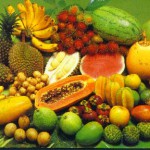Nutrition
On Sept 26, 2012, Food Standards Australia New Zealand (FSANZ) announced a six week public consultation for Application A1069, an application made by the Queensland government for approval to irradiate tomatoes and capsicums. In August 2014 the same agency entrusted with policing food safety is pushing for further approvals of irradiation of apples, apricots, cherries, nectarines, peaches, plums, honeydew, rockmelon, strawberries, table grapes, zucchini and squash – dramatically increasing the amount of foods likely to be included in a person’s usual diet.

In the US many fruits, vegetables and meats are irradiated despite the known nutritional affects and many cases of animal neurological affects
Herbs, spices, herbal infusions and nine tropical fruits had been approved for irradiation in Australia and New Zealand since the late 1990s. Pet foods, medicinal goods, and seeds and grains for animal consumption may also be irradiated because they are not classified as “food” under Australian law as they fall under different regulations and require no labelling.
While acknowledging in its assessments and fact sheets that irradiation may deplete vitamin and nutritional content, FSANZ has so far justified irradiation approvals on the basis that the approved foods made up a minimal part of the Australian and New Zealand diet. But that will dramatically change if irradiated tomatoes and capsicums are approved as these foods are regularly consumed as a core part of the diet by the Australian and New Zealand public. People from Southern European cultures in particular have a high consumption of both vegetables.
Recent surveys show that 59% of Australians purchase fresh tomatoes in their weekly shopping and the average Australian consumes an estimated 23kgs of tomato-based products per year. ii Tomatoes are second to potatoes and potato products as New Zealand’s top selling vegetable. iii
Despite FSANZ’s support and proponents’ claims, irradiation has not been proven safe as no long term studies of consumption of an irradiated diet have been conducted.
Between 2008 and 2009, approximately 100 Australian cats developed neurological disorders which led to their paralysis and, in some cases, death. The cause was identified as the consumption of irradiated cat food imported from Canada. These cases of harm to animals are clear evidence that irradiation may also have negative health impacts on humans. As a result, irradiated cat food is now banned in Australia.

Art Ryan’s cats became ill after eating irradiated food. Between 2008 and 2009, approximately 100 Australian cats developed neurological disorders which led to their paralysis and, in some cases, death.
FSANZ suggests that the impact of irradiated food on cats was species-specific. However, the US Food and Drug Administration (FDA) is now currently investigating the possibility that consumption of irradiated food has also led to the deaths of 360 dogs and 1 cat, and illness in 2,200 dogs since 2007.
Exposing food to ionizing radiation disrupts its molecular make-up, producing free-radicals and potentially other toxic chemicals such as benzene and formaldehyde.
Ionising radiation also creates new chemicals called “radiolytic products”, some of which do not usually occur naturally in food. The impacts of these have not been adequately studied. One, 2-ACBs, has recently been found “to promote the cancer-development process in rats, cause genetic damage in rats and cause genetic and cellular damage in human and rat cells.” v8
“Irradiation destroys and disrupts vitamins, proteins, essential fatty acids and other nutrients in food – sometimes significantly. It can destroy up to 80 percent of vitamin A in eggs and 48 percent of betacarotene in orange juice.” vi
Irradiation produces free radicals in food and has been linked to health problems such as nutritional deficiencies, immune system disorders, and genetic damage.
